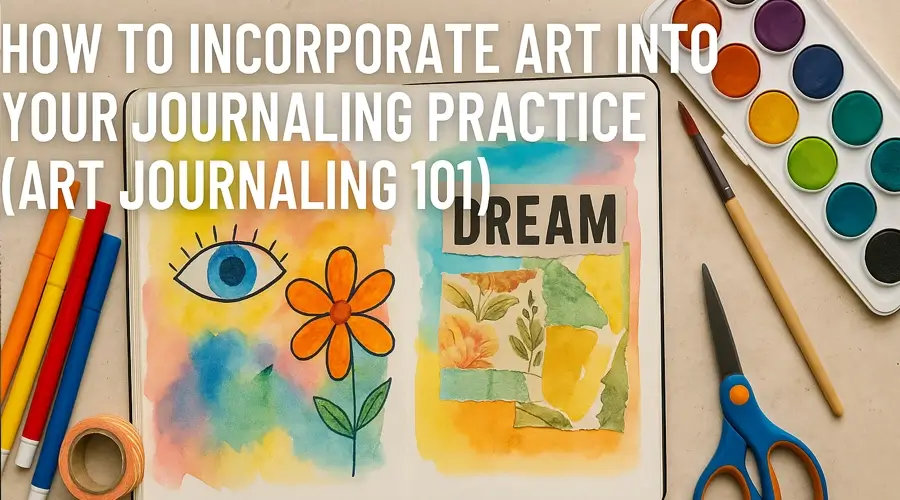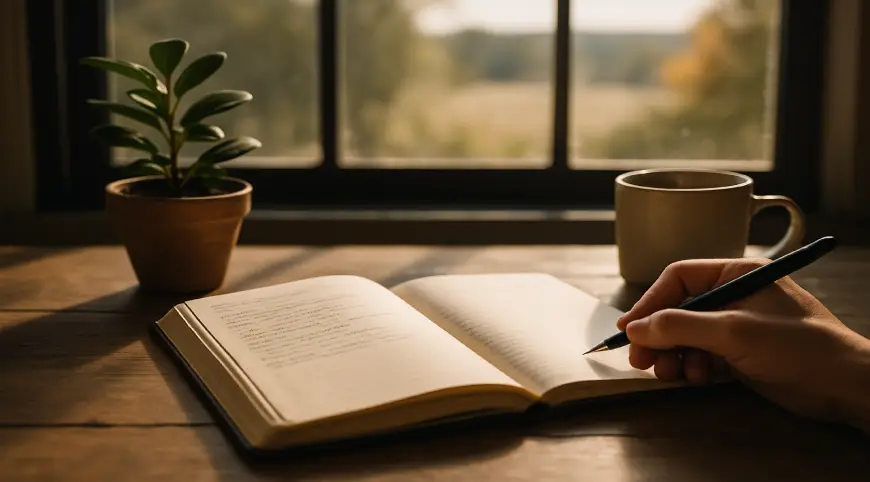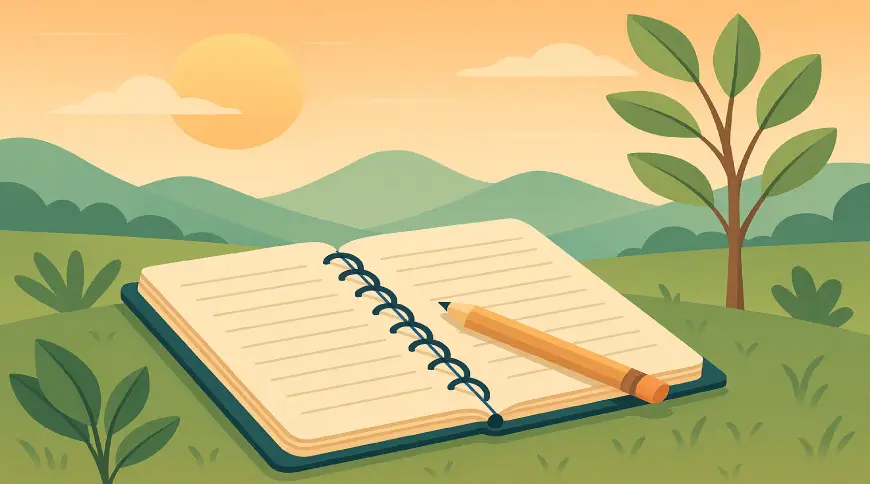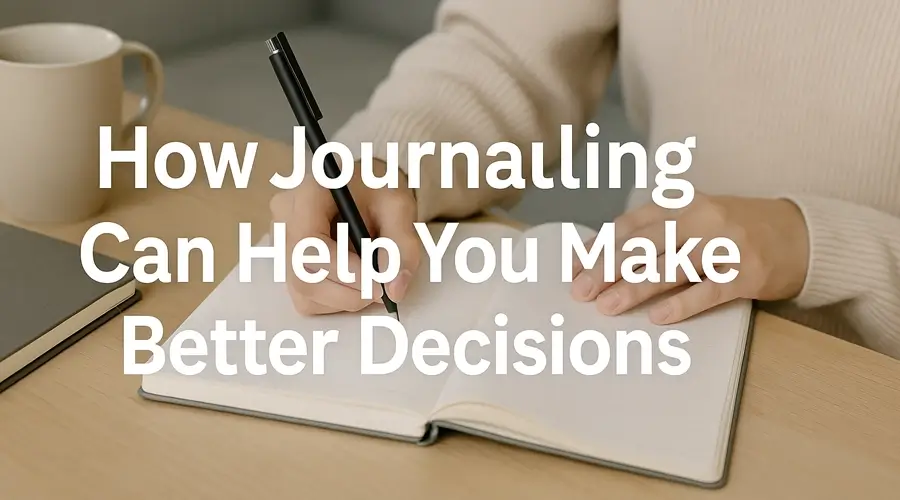For many of us, journaling begins with a pen and a blank page. We pour our thoughts out in writing — a stream of consciousness that captures our worries, dreams, or daily life. But what if words aren’t enough?
Sometimes emotions are too tangled to name. Sometimes ideas need colors, textures, or shapes to feel real. That’s where Art Journaling steps in — not just as a hobby, but as a powerful practice for stress relief, creative expression, and self-discovery.
Unlike traditional journaling, Art Journaling invites you to combine text with sketches, doodles, collage, watercolor, or anything else that feels right. It’s personal, messy, and beautifully imperfect — just like life. There are no rules, no expectations, and no artistic skills required. It’s about creating a space that reflects who you are, not who you think you should be.
Whether you’re looking to process emotions, unlock your creativity, or simply enjoy a mindful moment in your day, Art Journaling offers a flexible and deeply rewarding way to make your journal truly yours.
What Is Art Journaling, Really?
Let’s clear something up: Art Journaling isn’t just about making pretty pages for Instagram. It’s about creating an honest space where visuals and words work together to tell your story.
At its core, Art Journaling is a fusion of creative writing and visual art. Some pages may be covered in colorful paint and chaotic doodles. Others may hold a single line of poetry next to a torn magazine photo. There are no templates — just self-expression in its rawest form.
You don’t need to be a painter or poet to start. All you need is the willingness to explore your thoughts through creative journaling methods. It can be as simple as sketching your mood, adding color swatches that match your energy, or pasting in a ticket stub that means something only to you.
Think of your art journal as a visual diary, one where paint splatters can express more than paragraphs ever could. Whether you’re processing complex emotions, reflecting on your day, or simply experimenting with color and form, Art Journaling becomes a practice of mindfulness and discovery.
And best of all? There’s no right or wrong. Only truth.
Who Is Art Journaling For? (Hint: You)
Let’s bust one of the biggest myths right now:
“I’m not an artist, so I can’t do this.”
Wrong. You absolutely can.
Art Journaling isn’t reserved for professional painters or people who took design classes in college. It’s for anyone who wants to think, feel, reflect—or just breathe. If you’ve ever struggled to put your emotions into words, or if traditional journaling feels limiting, this creative path might be exactly what you need.
It’s perfect for:
- Beginners, because there are no rules and no pressure.
-
Perfectionists, because it helps loosen that grip and invites playful imperfection.
-
Overthinkers, because the process of layering colors, textures, and shapes calms the racing mind.
-
Visual thinkers, because sometimes images say what words can’t.
Whether you’re doodling after a tough day or collaging your goals for the year, Art Journaling becomes a gentle form of emotional well-being. It supports mindfulness by keeping you present, and promotes creative healing by giving your inner world a safe, expressive outlet.
So, who is Art Journaling for?
If you’re curious, craving creativity, or just need a place to feel—it’s for you.
Getting Started: Tools You Actually Need
One of the best things about Art Journaling? You don’t need a studio full of supplies or a shopping cart loaded with fancy tools to begin. In fact, starting small is often better—it keeps things simple, approachable, and free from pressure.
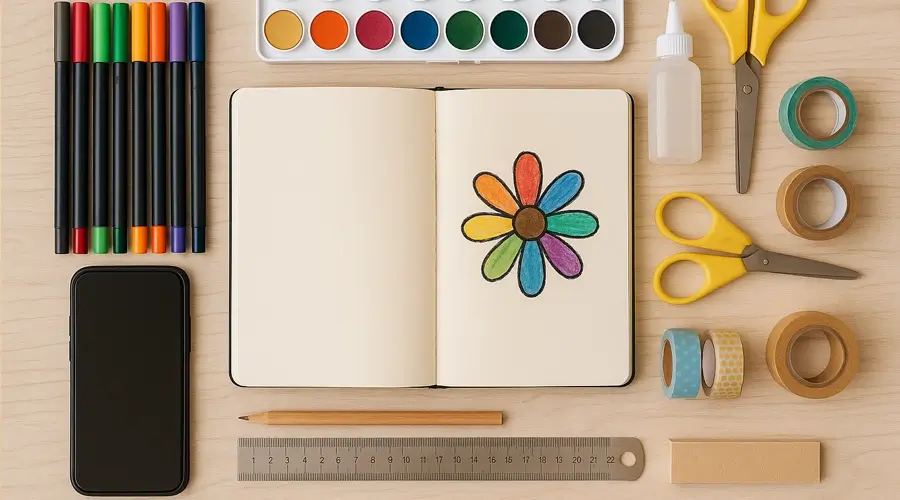
Let’s keep it minimal. All you truly need are:
-
A sketchbook or any notebook with sturdy pages
-
A few markers or pens
-
Basic glue or adhesive tape
That’s it. Seriously.
Of course, if you want to spice things up a little, here are some fun optional add-ons:
-
Watercolor sets for dreamy backgrounds and color blends
-
Washi tape to add texture and borders
-
Stickers, stamps, or printables to create quick, layered designs
-
A small set of colored pencils or pastels if you like soft gradients
This isn’t about collecting the most expensive art journal supplies—it’s about using what inspires you. Many people even create their own DIY journaling kits using leftover paper, old magazines, ticket stubs, and receipts. The magic lies in the intention, not the tools.
Start with what you have. Let the process evolve naturally. Your journal doesn’t care about your materials—it cares that you showed up.
Creative Prompts to Unlock Your Visual Voice
If you’ve ever sat in front of a blank page thinking, “Where do I even start?” — you’re not alone. That’s where creative prompts come in. They’re like open doors to your inner world, guiding you to express emotions, ideas, and memories in a visual language that feels true to you.
Here are some simple but powerful art journaling prompts to get your imagination flowing:
-
“Draw how your anxiety looks.”
Let the lines be messy, the colors intense. This isn’t about beauty—it’s about honesty. -
“Collage your dream future.”
Flip through old magazines or print pictures online. Cut, tear, paste. Build a world that excites you. -
“Turn today’s song into colors.”
What does that melody look like on paper? Is it sharp and bold or soft and washed out? -
“Document your day in symbols only.”
No words allowed. Just icons, patterns, and tiny illustrations that represent your moments. -
“Paint with your non-dominant hand.”
Let go of control. Watch what happens when perfection isn’t the goal.
These kinds of visual storytelling exercises open up new ways of thinking—and feeling. They bypass the logic-driven part of your brain and tap into something deeper and more instinctual. Your visual voice isn’t something you find, it’s something you uncover, layer by layer, page by page.
Remember: a prompt is just a spark. Where it takes you is entirely up to you.
The Psychology Behind Art Journaling
There’s a reason why Art Journaling feels so healing—it’s not just creative; it’s deeply psychological. When you engage with colors, textures, and images, you’re tapping into a different part of your brain—one that doesn’t need grammar or structure to make sense of what you’re feeling.
In a world where we’re constantly thinking, analyzing, and overexplaining, visual expression offers a shortcut to the subconscious. It bypasses the inner critic and gives space to raw emotion. That’s why many therapists and mental health professionals recommend Art Journaling as a tool for emotional regulation, trauma processing, and self-reflection.
Here’s what makes it so powerful:
-
Neuroaesthetics: Engaging with visual art has been shown to activate reward centers in the brain. Even just looking at your own colorful page can trigger a calming response.
-
Mindfulness through motion: The act of drawing, painting, tearing paper, or layering images forces you to slow down and stay present in the moment.
-
Safe emotional release: Instead of bottling things up, you externalize them—sometimes without even needing to understand them fully.
-
Creative problem-solving: Visual journaling builds new neural pathways by encouraging you to approach life’s challenges in nonlinear, symbolic ways.
Art Journaling doesn’t just help you “feel better”—it helps you understand yourself better. It’s a gentle mirror, one that reflects not just what you think, but how you feel.
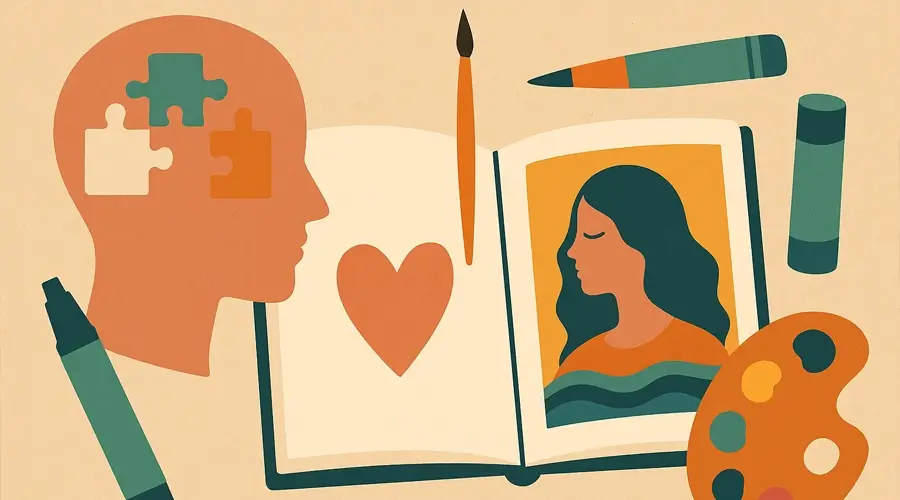
From Blank Page to Beautiful Mess: Workflow Tips
Every Art Journaling journey begins with the same quiet challenge: a blank page. And for many, that empty space can feel oddly threatening. It whispers, “What if I mess it up?” or worse—“What if I’m not creative enough?”
Here’s the secret: that blank page is not a test. It’s an invitation.
Instead of trying to make something perfect, aim to make something honest. Embrace the idea that your journal isn’t a gallery—it’s a sandbox, a place to play, experiment, and process. Here are a few workflow tips to help you move from hesitation to happy mess:
-
Start with a background.
Add a light watercolor wash, glue in a piece of old book paper, or scribble with a crayon. Once there’s something on the page, the pressure eases. -
Layer freely.
Don’t be afraid to paint over something you don’t like. Art Journaling is a living process. Your page can (and should) evolve. -
Add bits over time.
You don’t have to finish a spread in one sitting. Let it unfold day by day. A doodle here, a quote there—it adds richness. -
Use “mistakes” as texture.
Smudges, rips, uneven lines—they’re not flaws. They’re personality. -
Make it a ritual, not a task.
Light a candle, play soft music, or journal by the window. Make it feel like a gift to yourself.
The goal isn’t to impress—just express. Whether your journal is messy or minimal, it’s a reflection of you.
Not into paper and glue?
✨ Try VERBOAI, your digital space for Art Journaling—where creativity meets mindfulness, no paintbrush needed.
Common Struggles and How to Overcome Them
Even the most creative practices have their rough days—and Art Journaling is no exception. If you’ve ever found yourself making excuses or feeling stuck, you’re not alone. Let’s tackle some of the most common struggles with friendly, practical solutions:
“I don’t have time.”
You don’t need an hour and a perfect setup. Try a 5-minute journaling ritual—a quick sketch while your coffee brews or a splash of color before bed. The point isn’t how long it takes, it’s that you show up. A few minutes of creativity still counts.
“It never looks good.”
That’s completely normal—and honestly, not the point. Art Journaling is about how it feels, not how it looks. Try using your non-dominant hand, scribble with your eyes closed, or collage randomly. Releasing the pressure to make it “beautiful” is often the first step to making it meaningful.
“I run out of ideas.”
Creative block happens. Keep a list of your favorite art journaling prompts or follow themed challenges online. You can even use music lyrics, dreams, or yesterday’s thoughts as a starting point. Inspiration is everywhere—you just need to train your eye to spot it.
Remember, your Art Journal isn’t about perfection. It’s a reflection of your process, your feelings, and your growth.
Sharing Your Art Journal (Or Not)
Once you start filling pages with color, emotion, and meaning, a question might come up: Should I share this?
The truth is, Art Journaling is first and foremost for you. You don’t owe anyone a peek inside your pages. But if you do feel inspired to share, there’s a beautiful community out there ready to celebrate your work—flaws, mess, and all.
If you want to share:
-
Join platforms like Instagram, Pinterest, or Reddit where Art Journaling hashtags thrive.
-
Participate in monthly challenges or share process videos instead of finished spreads.
-
Focus on connection, not validation.
If you don’t want to share:
-
That’s perfectly okay—and sometimes more powerful.
-
Keeping your pages private allows for full emotional freedom.
-
Your journal becomes a sacred space, a mirror just for you.
There’s no “right” way. Whether you go public, stay private, or bounce between both, what matters is that you’re showing up for your own creative journey.
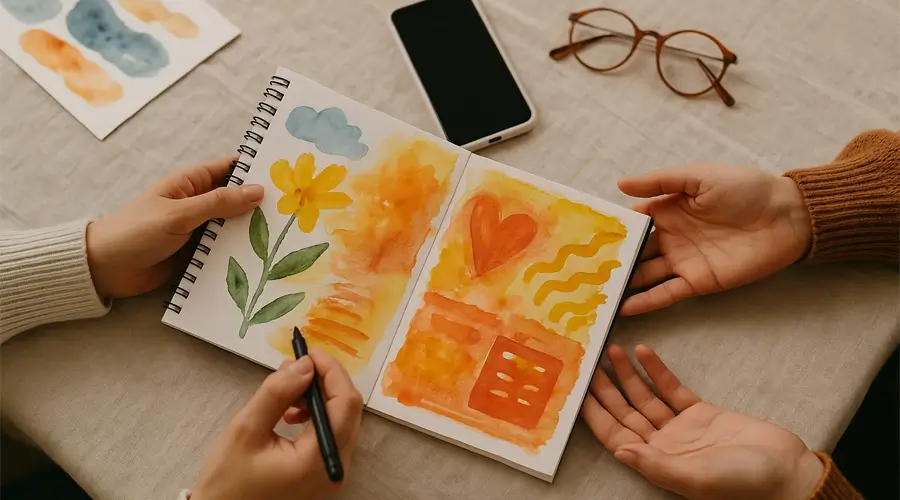
Final Thoughts: Art Journaling as a Lifelong Companion
Art Journaling isn’t a trend—it’s a practice. One that can walk beside you through chaos and calm, heartbreak and healing, questions and clarity.
Over time, your journal becomes more than just a collection of pages. It turns into a witness. A quiet, nonjudgmental space that has seen your growth, your confusion, your breakthroughs, and your everyday beauty.
Some seasons, you might journal every day. Other times, your sketchbook might gather dust. That’s okay. Like any relationship, it ebbs and flows. What matters is that it’s there when you need it.
Whether you use paper, paint, or a digital tool like VERBOAI, the act of showing up for yourself creatively is powerful. It reminds you that your voice matters—even when it’s scribbled, layered, abstract, or unfinished.
